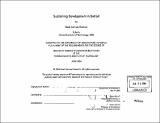| dc.contributor.advisor | Julian Beinart. | en_US |
| dc.contributor.author | Resnick, Noah Samuel, 1977- | en_US |
| dc.contributor.other | Massachusetts Institute of Technology. Dept. of Architecture. | en_US |
| dc.coverage.spatial | n-us-mi | en_US |
| dc.date.accessioned | 2005-09-06T21:25:00Z | |
| dc.date.available | 2005-09-06T21:25:00Z | |
| dc.date.copyright | 2004 | en_US |
| dc.date.issued | 2004 | en_US |
| dc.identifier.uri | http://hdl.handle.net/1721.1/27036 | |
| dc.description | Thesis (S.M.)--Massachusetts Institute of Technology, Dept. of Architecture, 2004. | en_US |
| dc.description | Includes bibliographical references (p. 90-91). | en_US |
| dc.description.abstract | The intent of this thesis is to propose a strategy for stabilizing and increasing the disparate pieces of development that form the traces of the once great industrial city of Detroit. It focuses primarily on Fordism as a type of modernist urbanism in which a powerful socio-economic agenda manipulated the growth of the city to that of a horizontal decentralization, dependent on the automobile. The design investigation develops and tests the thesis that a large-scale mass transit system is an integral, if not central component to any successful urban plan. It also proposes radical new uses of the vast amounts of vacant land left behind by the deserted population and industries. The first stage of this investigation examines the urban, social, and economic history of Detroit. It traces its decline from the most powerful industrial city in the early twentieth century, to the seemingly empty shell that was left behind after the race riots of the sixties, and the city's lack of recovery since. The urban design proposal is then framed around a hypothetical network of mixed capacity surface transit and commuter rail lines. Several intermodal nodes are determined and the transit stations located at these points form an armature around which various types of development can occur. The goal of the plan is to integrate and connect the labor, wealth, culture, and history of the region, and focus these into the downtown area. | en_US |
| dc.description.statementofresponsibility | by Noah Samuel Resnick. | en_US |
| dc.format.extent | 95 p. | en_US |
| dc.format.extent | 9631828 bytes | |
| dc.format.extent | 9631051 bytes | |
| dc.format.mimetype | application/pdf | |
| dc.format.mimetype | application/pdf | |
| dc.language.iso | en_US | |
| dc.publisher | Massachusetts Institute of Technology | en_US |
| dc.rights | M.I.T. theses are protected by copyright. They may be viewed from this source for any purpose, but reproduction or distribution in any format is prohibited without written permission. See provided URL for inquiries about permission. | en_US |
| dc.rights.uri | http://dspace.mit.edu/handle/1721.1/7582 | |
| dc.subject | Architecture. | en_US |
| dc.title | Sustaining development in Detroit | en_US |
| dc.type | Thesis | en_US |
| dc.description.degree | S.M. | en_US |
| dc.contributor.department | Massachusetts Institute of Technology. Department of Architecture | |
| dc.identifier.oclc | 56793061 | en_US |
